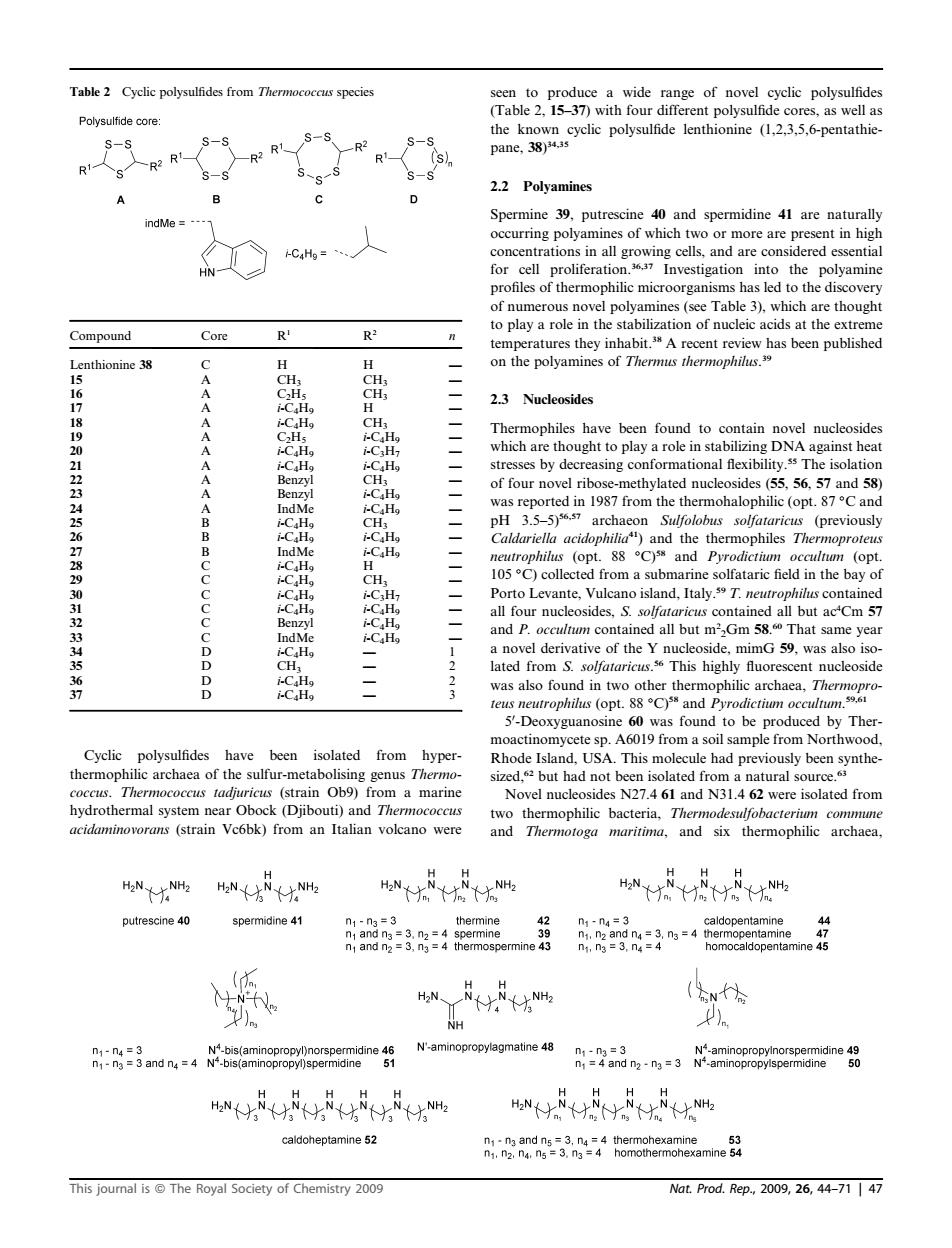正在加载图片...

Table 2 Cyclic polysulfides from Thermococcus species 2.2 Polyamines zation of nucleic Compound Core R at the 2.3 Nucleosides 23 nuc 7 26 B dM C.H CG西Ae 30 Porto Levante.Vulcano island.ItalyT.rcontained 3 the y omimG 59. lated from S highly fuorescent nucleoside S'-Deoxguanosine 60 was found to be produced by Ther de I This molee Novel nucleosides N27.4 61 and N31.4 62 were isolated from an w大6大 大 w8H大 putrescine40 spermidine 41 的并…甜 材m (w au4o货nwA2品a内m分 w方为 w caldoheptamine 52 homomhemonexamne This joumal isThe Royal Socety of Chemistry 2009 Nat.Prod.Rep,2009,.26,4471147Cyclic polysulfides have been isolated from hyperthermophilic archaea of the sulfur-metabolising genus Thermococcus. Thermococcus tadjuricus (strain Ob9) from a marine hydrothermal system near Obock (Djibouti) and Thermococcus acidaminovorans (strain Vc6bk) from an Italian volcano were seen to produce a wide range of novel cyclic polysulfides (Table 2, 15–37) with four different polysulfide cores, as well as the known cyclic polysulfide lenthionine (1,2,3,5,6-pentathiepane, 38) 34,35 2.2 Polyamines Spermine 39, putrescine 40 and spermidine 41 are naturally occurring polyamines of which two or more are present in high concentrations in all growing cells, and are considered essential for cell proliferation.36,37 Investigation into the polyamine profiles of thermophilic microorganisms has led to the discovery of numerous novel polyamines (see Table 3), which are thought to play a role in the stabilization of nucleic acids at the extreme temperatures they inhabit.38 A recent review has been published on the polyamines of Thermus thermophilus. 39 2.3 Nucleosides Thermophiles have been found to contain novel nucleosides which are thought to play a role in stabilizing DNA against heat stresses by decreasing conformational flexibility.55 The isolation of four novel ribose-methylated nucleosides (55, 56, 57 and 58) was reported in 1987 from the thermohalophilic (opt. 87 C and pH 3.5–5)56,57 archaeon Sulfolobus solfataricus (previously Caldariella acidophilia41) and the thermophiles Thermoproteus neutrophilus (opt. 88 C)58 and Pyrodictium occultum (opt. 105 C) collected from a submarine solfataric field in the bay of Porto Levante, Vulcano island, Italy.59 T. neutrophilus contained all four nucleosides, S. solfataricus contained all but ac4 Cm 57 and P. occultum contained all but m2 2Gm 58. 60 That same year a novel derivative of the Y nucleoside, mimG 59, was also isolated from S. solfataricus. 56 This highly fluorescent nucleoside was also found in two other thermophilic archaea, Thermoproteus neutrophilus (opt. 88 C)58 and Pyrodictium occultum. 59,61 50 -Deoxyguanosine 60 was found to be produced by Thermoactinomycete sp. A6019 from a soil sample from Northwood, Rhode Island, USA. This molecule had previously been synthesized,62 but had not been isolated from a natural source.63 Novel nucleosides N27.4 61 and N31.4 62 were isolated from two thermophilic bacteria, Thermodesulfobacterium commune and Thermotoga maritima, and six thermophilic archaea, Table 2 Cyclic polysulfides from Thermococcus species Compound Core R1 R2 n Lenthionine 38 CH H — 15 A CH3 CH3 — 16 A C2H5 CH3 — 17 A i-C4H9 H — 18 A i-C4H9 CH3 — 19 A C2H5 i-C4H9 — 20 A i-C4H9 i-C3H7 — 21 A i-C4H9 i-C4H9 — 22 A Benzyl CH3 — 23 A Benzyl i-C4H9 — 24 A IndMe i-C4H9 — 25 B i-C4H9 CH3 — 26 B i-C4H9 i-C4H9 — 27 B IndMe i-C4H9 — 28 C i-C4H9 H — 29 C i-C4H9 CH3 — 30 C i-C4H9 i-C3H7 — 31 C i-C4H9 i-C4H9 — 32 C Benzyl i-C4H9 — 33 C IndMe i-C4H9 — 34 D i-C4H9 — 1 35 D CH3 — 2 36 D i-C4H9 — 2 37 D i-C4H9 — 3 This journal is ª The Royal Society of Chemistry 2009 Nat. Prod. Rep., 2009, 26, 44–71 | 47